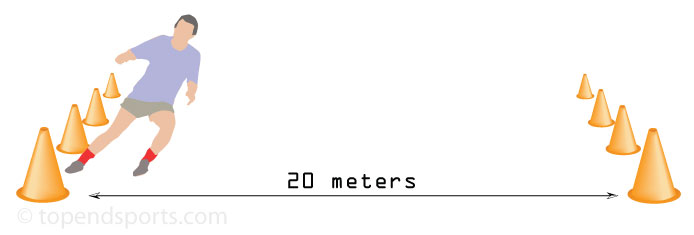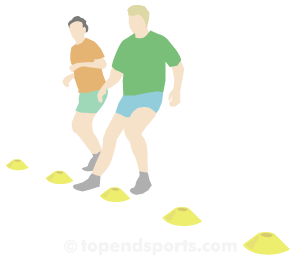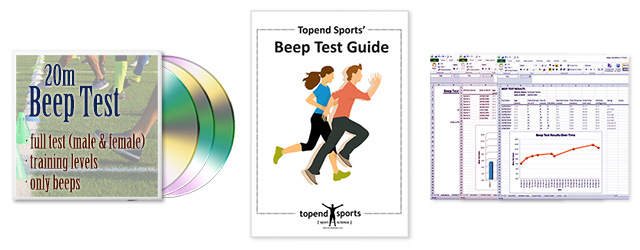The 20m multistage fitness test (MSFT) is a commonly used maximal running aerobic fitness test. It is also known as the 20 meter shuttle run test, beep or bleep test among other names. It is a maximal test involving continuous running between two lines 20m apart in time to recorded beeps. For more information on this test, see the complete guide to the bleep / beep test.
equipment required: Flat, non-slip surface, marking cones, 20m measuring tape, beep test audio, audio player, recording sheets.
pre-test: Explain the test procedures to the subject (many beep test audios have an explanation at the start of the recording). Perform screening of health risks and obtain informed consent. Prepare forms and record basic information such as age, height, body weight, gender, test conditions (particularly the weather and running surface). Measure and mark out the course. Ensure that the participants are adequately warmed-up. See more details of pre-test procedures.
procedure: This test involves continuous running between two lines 20m apart in time to recorded beeps. For this reason the test is also often called the 'beep' or 'bleep' test. The participants stand behind one of the lines facing the second line, and begin running when instructed by the recording. The speed at the start is quite slow. The subject continues running between the two lines, turning when signaled by the recorded beeps. After about one minute, a sound indicates an increase in speed, and the beeps will be closer together. This continues each minute (level). If the line is reached before the beep sounds, the subject must wait until the beep sounds before continuing. If the line is not reached before the beep sounds, the subject is given a warning and must continue to run to the line, then turn and try to catch up with the pace within two more ‘beeps’. The subject is given a warning the first time they fail to reach the line (within 2 meters), and eliminated after the second warning.

scoring: The athlete's score is the level and number of shuttles (20m) reached before they were unable to keep up with the recording. Record the last level completed (not necessarily the level stopped at). This norms table below is based on personal experience, and gives you a very rough idea of what level score would be expected for adults, using the standard Australian beep test version. There is a more detailed table of norms for the beep test. This level score can be converted to a VO 2max equivalent score using this calculator. You may also wish to check out the Beep Test Recording Sheet.
| men | women | |
|---|---|---|
| excellent | > 13 | > 12 |
| very good | 11 - 13 | 10 - 12 |
| good | 9 - 11 | 8 - 10 |
| average | 7 - 9 | 6 - 8 |
| poor | 5 - 7 | 4 - 6 |
| very poor | < 5 | < 4 |
target population: this test is suitable for sports teams and school groups, but not for populations in which a maximal exercise test would be contraindicated.
validity: The correlation to actual VO2max scores is high (see some of these references). There are published VO2max score equivalents for each level reached, which can be determined using this Beep VO2max Calculator.
reliability: The reliability of the beep test would depend on how strictly the test is run and the practice allowed for the participants. There are also other factors which can affect performance, which need to be controlled if possible. See point below.
advantages: Large groups can perform this test all at once for minimal costs. Also, the test continues to maximum effort unlike many other tests of endurance capacity.
disadvantages: Practice and motivation levels can influence the score attained, and the scoring can be subjective. As the test is often conducted outside, the environmental conditions can affect the results.
 comments: to increase reliability, you can give consistent instructions prior to the test and provide the same encouragement and apply the same strictness to when to finish the test.
comments: to increase reliability, you can give consistent instructions prior to the test and provide the same encouragement and apply the same strictness to when to finish the test.
factors to consider: Although the beep test is primarily a fitness test of the aerobic energy system, there is a range of other factors that can affect performance in the test and are important to consider. These include: running efficiency and turning technique, anaerobic capacity, motivation and social dynamics, motor skills and cognitive ability (especially in children), environmental differences, clothing and running surfaces, test familiarization and instructions, the purpose and context of testing
other considerations:
- This test goes by many names, though you need to be careful as the different names also may signify that these are different versions of the test. Therefore you need to be wary when comparing results or comparing to norms.
- This test is a maximal test, which requires a reasonable level of fitness. It is not recommended for recreational athletes or people with health problems, injuries or low fitness levels.
- One way to ensure that all athletes push themselves in the test is for them to wear a heart rate monitor. You can then compare their maximum heart rate during the test to their predicted or measured maximum to determine if they have 'maxed out'.
Variations and Other Beep Type Tests (more on Variations)
There are several versions of the test, but one commonly used version has an initial running velocity of 8.0 km/hr, then up to 9.0 km/hr for level 2 and then increases by 0.5 km/hr thereafter. Another version starts at 8.5 km/hr, then increases by 0.5 km/hr each minute (more on test variations, and see Beep test video examples).
- Aero Test — similar to the description above
- PACER test — similar to above, part of the FitnessGram and Brockport test batteries.
Beep Test Modifications (tests based on the standard beep test) - see more
- Yo-Yo Endurance Test — similar to above, part of the yo-yo series of tests.
- 15m Bleep Test — a 15m version of the standard 20m beep test.
- Birtwell 40m Shuttle — longer 40m shuttles with different timings
- Swimming Beep Test — the beep test for swimmers.
- Swimming Beep Test #2 — another pool based beep test.
- Multistage Shuttle Swim Test — designed for water polo players.
- Rowing Beep Test — incremental test performed on a rowing ergometer
- multistage field test — for wheelchair users.
- 10m Beep Test — designed for children with cerebral palsy (CP)
- Beep Test for the Vision Imparied
- Walk Test — for elderly participants walking around a rectangle in time to the beeps.
- Miller 20m Run — hybrid of a timed run test and the beep test.
Similar Tests
- List of Modified Beep Tests
Related Pages
- Beep Test audio file free download
- The complete guide to the beep test, for links to much more information about this test.
- Beep Test Norms — a score rating guide
- See Shuttle run video examples of the beep test being performed.
- Maximizing Your Score — to get the most out of the beep test.
- You can create your own variation of the beep test using the team beeptest software.
- References for the beep test.
- Beep Test Store — for purchasing the beep test audio file and other beep test products such as the Beep Test Recording Sheet.
- Calculating Your Score — calculator to determine your VO2max equivalent score.
- POLL: What do you call this (bleep?) test?
- What's your best score? some results of athletes. See also the Beep Test Records
BEEP TEST PACKAGE - only $10
The 20m Beep Test (male & female voices) + Training Levels + 'Beeps Only' track + Excel Spreadsheet + eBook Guide (PARQ, consent form, test recording sheet, warm-up, tips, norms + much more!)

The ultimate beep test package, including two versions of the beep test audio file (male and female voice), an audio track with only the beeps (no voices), 8 audio tracks for training at specific test levels, an Excel spreadsheet with an offline calculator and tables for recording, analyzing and presenting results, a 12-page eBook beep test guide which includes a PARQ, informed consent form, and test recording sheet plus much more. All these files are available individually for $5 each, or even better get them all for $10. Check out the details.
Old Comments
Commenting is closed on this page, though you can read some previous comments below which may answer some of your questions.
- Hi guys, My score was 10.2 last time I tried, I was feeling to run but somewhat I found myself running out of energy so I stooped. Can anyone give me some tip or idea how to overcome? Actually I need to score over 13 in a week. Justin (2013)
- My grandson scored 17.2 on the bleep test as laid down by WRU he is 13. can you tell me if this is good please? thanks Janis. Janis Woodfield Raven (2013)
- His beep test is obviously good as evidenced by the INCLUDED results table. Shame about his genetic intelligence level judging by his grandmothers lack of reading comprehension. Janis Woodfield Raven (2013)
- Are you kidding me how can you get so mad about such a silly thing that she missed de table? OMG. Isa (2013)
- That's not possible. Maybe that was on an other beep test on the 400m. Tom Janis Woodfield Raven (2014)
- It is quite unlikely that your grandson scored 17.2 on the 20m multistage fitness test considering the recorded world record for it is 17.1, however some younger students do a different version of it or a shorter distance. Joe Janis Woodfield Raven (2014)
- the world record aint 17.1 I got 19.3. Utuii Joe (2014)
- it was not measured right. no way could he get 17.2 AFL players don't even get 17. Ben Janis Woodfield Raven (2014)
- Hi guys, My score was 10.2 last time I tried, I was feeling to run but somewhat I found myself running out of energy so I stooped. Can anyone give me some tip or idea how to overcome? Actually I need to score over 13 in a week. Justin (2013)
- Pace yourself through the whole Bleep test. My first bleep test was 10.3 which I didn't think was very good however it is nearly impossible to increase that many levels in one week so what I did was a 6-week workout program for my muscular endurance and also my cardiovascular system; the training methods I used were Circuit training for high/medium work intensity and then continuous training which over the six weeks improved my muscular endurance in my lower body which allowed me to with stand the pain in my muscles a lot better, and also this increased my cardiovascular system too as I was able to get more oxygenated blood to my muscles in need of it. So I would say try either a high intensity 3-week workout program or a mid intensity workout program for 6-weeks which I feel is the better option as you don't force your body to adapt to things so fast. Now my bleep test is around 13.5/13.7 which according to the normative data it "Excellent". Hope this helps. Lewis Hind justin (2017)
- Wow! What an interesting and exciting test! I love the beep test! It makes me squeal with enjoyment! I'm really good at it! Praise me! Deelan (2013)
- Hi guys, My score was 2.1 last time I tried, I want to join the prison service, have you any idea what I need to join? Thank you guys. Jordan Witter (2013)
- I think u need to practice alot more. Jj Jordan Witter (2014)
- how in the world did u get 2.1 a toddler could get 5. something!!!!!!! Utuii Jordan Witter (2014)
- A toddler could write and spell better than you. Gregory Williams utuii (2016)
- That's really mean. Some people just don't have the endurance to run the beep test. Ella utuii (2014)
- 2.1 is literally walking though. Graeme ella (2017)
- Hope you achieved what you wanted! Gregory Williams Jordan Witter (2016)
- You need to get to 5.4 to join the prison service. Martin Jordan Witter (2013)
- Hey, I was wondering, I am 13 and i got 12.2 on the test. Is that good? I play a lot of competitive football and I was wondering. My friend was doing it with me and he stopped at 11.4. Is it normal to get 12.2 for my age. Thank. Coko Gaming (2017)
- guys what do they mean by shuttles?? Admin- A shuttle is each 20m run distance. Anime_God 14 (2017)
- Keep quiet, I went to 19.3 and buddies of mine did 20.7 so stop acting so mucho. People doent acctualy record the best person. You'll probably find that someone did 30. Kalib (2016)
- the world record for beep test is 17...so congrats to you and your friends who reached 19 and 20...about someone who did 30...are you sure that guy (it) is from earth? Issac Zheng (IM) Kalib (2017)
- Hello, I'm a twelve year old girl and I got about 12.7 seconds running 30 meters back and forth twice. Is this good? Thanks. Random Person (2016)
- well done on breaking the 100m world record for men (taking in the time to turn around in to factor). Move over Usain Bolt! Brant Nuttall Random Person (2017)
- I achieved 3.3 on the beep test recently, I was really proud of this score. Can you tell me if this was any good. Rachel Workman (2016)
- No it was terrible you need to improve I'm 14 and got 10 nearly 11. Reuben Rachel Workman (2017)
- Today at school i scored level 18, shuttle 3, i'm 14 years old and i think i broke the world record! This was the 20m multi-stage fitness test, no variations involved. I might try out for the olympics marathon in 2018. Wesley Betts (2016)
- Hi, I have the Topend Sports bleep test app and on setting up players it asks for weight but does not mention the measurement for this. Im in uk so would go with stones and pounds but im not sure what the US measure in? Eilef (2016)
- Hi Eilef. What app are you using? Topend Sports does not have its own beep test app, though I sell a few different ones through this website. Here in Australia we use kilograms for weight, the US like the UK have not yet fully adopted the metric system. Rob Admin Eilef (2016)
- I will be using the beep test for a person in a wheelchair, is it still the same beep test or do I need a different version for them to get to the various turning positions? Curisoto (2015)
- Have you seen this page? This modified beep test for wheelchair users starts a bit slower than the regular test and has smaller speed increments. It also has a square course so the turns are not so sharp. So I think using the standard beep test audio will be too difficult for a wheelchair user to keep up for long. It is a great idea to include everyone in the test, though whatever you do it will be difficult to get any meaning from their test score. You may have to play around with the distance to get a setup so that they can get comparable scores. Maybe just a 10 meter course for the person in a wheel chair. It is just guesswork. Rob Admin curisoto (2015)
- Someone please tell me how the scoring system works. Kelvin Beard (2015)
- Hey I was wondering if anyone could tell me how you can calculate Vo2max on children age>8 with the 20mSRT. I can only find ages down to 13 years old? YNWA (2015)
- Hi guys, I scored 13.3 in the bleep test and I'm only 13 years old. can someone tell me if its a good or bad score?. The length was exactly 20m. Oskar (2014)
- I have the following questions: if the above is for adults, what are the rules for kids. i have a u13, 12 year old. Her coach reduces the length from 20 meters to 16 meters and wants the team to get a minimum of 10.11. Question is, do you keep the same time as adults but reduce the distance? This would make it easier. or
do you start at the same speed, 8.5 k/hr (starting out) based on the reduced distance? This would keep the same pace, thus reduce the time between intervals. I am not sure this is that much easier as it gets harder sooner at the same pace. Scott (2013)
- The stated speeds for each level is based on running 20m. Using the same recording, if the distance is reduced then the speed required to travel that shorter distance in the same time is also lower. for example, it takes about 8.5 seconds to cover the 20m in the first shuttle. If you still have 8.5 seconds to cover 16m, an average running speed of only 6.8 km/hr would be required. Rob Admin Scott (2013)


 Current Events
Current Events